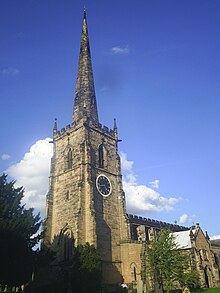St. Wystan's Church, Repton
| St. Wystan's Church, Repton | |
|---|---|

Repton Church
|
|
| 52°50′26″N 01°33′11″W / 52.84056°N 1.55306°WCoordinates: 52°50′26″N 01°33′11″W / 52.84056°N 1.55306°W | |
| OS grid reference | SK 303 272 |
| Country | United Kingdom |
| Denomination | Church of England |
| Churchmanship | Broad Church |
| Website | reptonchurch.org.uk |
| History | |
| Founded | Repton Abbey established c.600AD |
| Founder(s) | Saint David (traditionally) |
| Dedication | St Wystan |
| Relics held | St Wystan (moved by King Cnut to Evesham Abbey) |
| Architecture | |
| Status | Parish church |
| Functional status | Active |
| Heritage designation | Grade I listed |
| Designated | 19 January 1967 |
| Architect(s) | Arthur Blomfield (restoration) |
| Architectural type | Church |
| Style | Anglo-Saxon, Gothic |
| Specifications | |
| Spire height | 212 feet (65 m) |
| Clergy | |
| Vicar(s) | Revd. Peter Paine |
St. Wystan's Church is an Anglican parish church in Repton, Derbyshire that is famous for its Anglo-Saxon crypt which is the burial place of two Mercian Kings. The church is recorded in the National Heritage List for England as a designated Grade I listed building, and is dedicated to the Anglo-Saxon Saint Wystan (or Wigstan), who was formerly buried within the church's crypt.
For early history, please see: Repton Abbey
The Anglo-Saxon abbey church was cruciform and may have had a tower over its central crossing. The nave of the current church has Medieval Gothic north and south aisles that were rebuilt in the 13th century and widened early in the 14th century. The west tower and recessed spire were added in 1340. The top of the spire is 212 feet (65 m) above ground level. In the 15th century the nave clerestory with its timber roof and the two-storey porch were built and the tower windows were altered. Monuments inside the church include an alabaster effigy of a knight from about 1400 and monuments to members of the Thacker family from 1563 and 1710. The tower has a ring of eight bells, the oldest of which was cast at Leicester in about 1500.
The church was restored between 1885 and 1886 by Arthur Blomfield.
The Crypt was constructed in the early 8th century; it was built over a spring and is thought to have originally been a baptistery.
It was converted into a mausoleum for King Æthelbald of Mercia, during his lifetime. King Wiglaf and his grandson Saint Wigstan (after whom the later church is named), were also buried in the crypt.
...
Wikipedia

